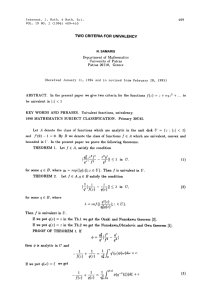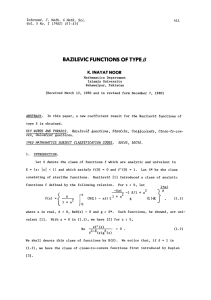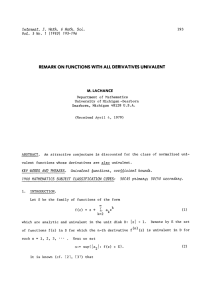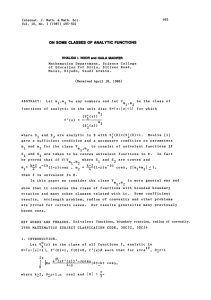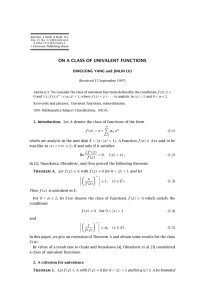UNIVALENT FUNCTIONS nt. J. No. QUASI-CONVEX
advertisement
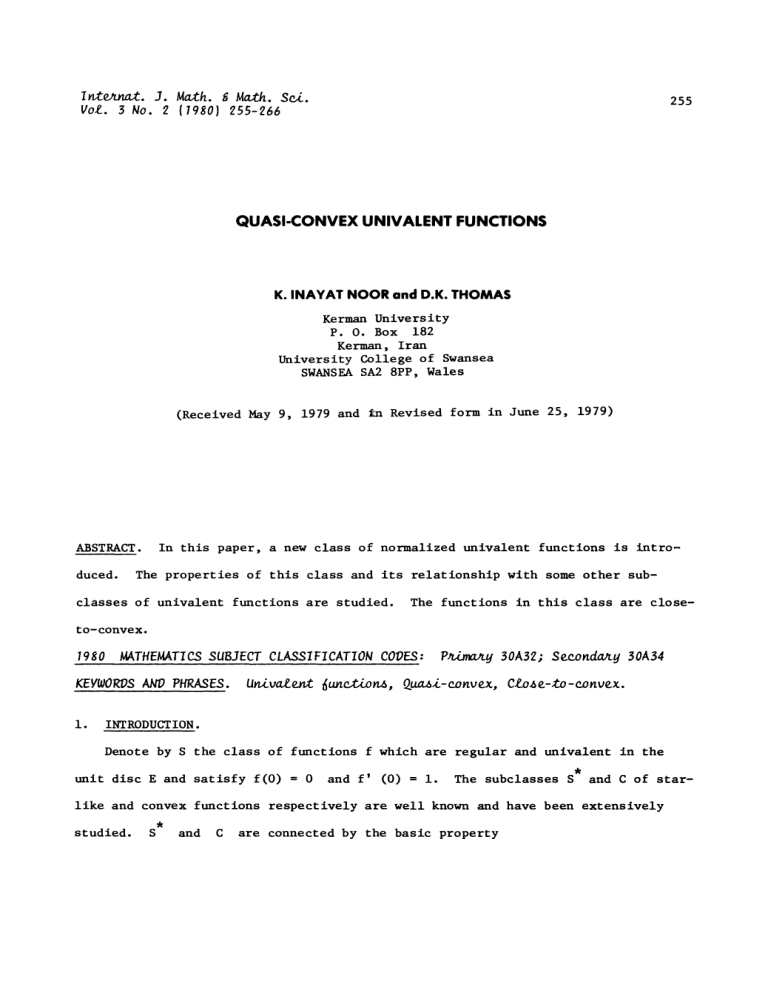
I nt. J. Math. Math. Si.
No. 2 (1980) 255-266
255
Vol.
QUASI-CONVEX UNIVALENT FUNCTIONS
K. INAYAT NOOR and D.K. THOMAS
Kerman University
P. O. Box 182
Kerman, Iran
University College of Swansea
SWANSEA SA2 8PP, Wales
(Received May 9, 1979 and
Revised form in June 25, 1979)
In this paper, a new class of normalized univalent functions is intro-
ABSTRACT.
duced.
n
The properties of this class and its relationship with some other sub-
classes of univalent functions are studied.
The functions in this class are close-
to-convex.
1980 MATHEMATICS SUBJECT CLASSIFICATION CODES:
KEFWORDS AND PHRASES.
1
Primary OA2; Secondary 0A34
Univalent functions, Quasi-nvex, Close-to-nvex.
INTRODUCTION
Denote by S the class of functions f which are regular and univalent in the
unit disc E and satisfy f(0)
0
and f’ (0)
i.
The subclasses S
,
and C of star-
like and convex functions respectively are well known and have been extensively
studied.
S
,
and
C
are connected by the basic property
K. I. NOOR AND D. K. THOMAS
256
C
f
The subclass
known and
K
S
of
zf’ e S
if and only if
,
(i.i)
consisting of close-to-convex function is also well
,
many of the properties of
can be extended to the wider class K.
S
The purpose of this paper is to introduce a natural analogue of the class
C
in terms of the property defined in (i.i).
MAIN RESULTS.
2.
Def.
be
Let
f
quasi-convex
g’(0)
E
be regular in
E
in
with
0 and f’(0)
f(O)
if there exists a convex function
1 such that for
z e
I.
Then f is said to
with g(0)
g
0,
E,
.(zf’ (z))’
g’ (z)"
Re
(2.2)
0.
>
Denote the class of quasi-convex functions by Q.
It is clear that
that Q
c
when
f(z)
g(z), C
Q so that
C
Q.
c
We show first
K, so that every quasi-convex functions is univalent.
THEOREM I.
Let f e Q.
Then, for z e E,
Re
and so Q c K
univalent in
PROOF:
c
S
__zf..’.(z).
> 0
g(z)
thus, every quasi-convex function is close-to-convex and hence
E.
A result of Libera [4] shows that, if
gular in E with s(0)
t(0)
Re
,
0 and t e S
__s.’_(z)
t’(z)
>
0
An immediate application of this with s(z)
s
and
Re
s(z)
t(z)
are functions re-
E,
then for z
+
t
>
O.
zf’ (z) and t(z)
g(z) proves
QUASI-CONVEX UNIVALENT FUNCTIONS
257
Theorem i.
It follows at once from the definition that
Q if and
f
only if zf’ e K.
(2.2)
We can thus write
C
>
S
Q
>
K
where the direction of the arrow indicates set inclusion.
Theorem i shows that
the image domain for all f e Q
is close-to-convex.
However a specific characterisation of the image domain for f e Q remains an open
question.
we
state now
some basic properties of quasi-convex functions which can easily
We omit the proofs as they are
be extended from the class of convex functions.
simple extensions from the convex case.
THEOREM 2.
Let f e Q with f(z)
+
z
n=2
(i)
lanl
<
(l+r)
2-
r
w
n
If’(z)
>
1/2
Then for
If
(z)
where
zl
r < i,
in
E
2,3,...,
<
(l-r)
<_
l+r
(iv)
n
< i,
(+/-i)
(iii)
a z
n
-<
2
r
l-r
f(z)+ w
All inequalities are sharp, equality being attained for
f0(z)
Z
l-z
258
K. I. NOOR AND D. K. THOMAS
We now give an example of a function in Q
Let
Example 1 3 1
maps
E
i-i
fl
which is not convex.
z
fl(z)
be the Koebe function; i e
(-z)
conformally onto the w-plane cut from-
x+
f2:f2 "(z)
Then
f3
f3(z)
f3" (0)
0 (since
f3
fl[f2(z)]
fl(x)
is univalent), and let
maps
0
and
f4
f3 (z)
f4 (z)
f2
by
f3(0)
E.
z
f’0-----
Combining all these transformations, we can write
F(z)
fl +_z )_ i)
f
The function
F
fl(x
+ xz
(x)
z
(i- z) 2
(-Ix
is close-to-convex.
In fact,
fl/X+
1 .z/
z
F’(z)
+
fl(x)
(i
+
x--z)2
F"(z)
F’ (z)
(i + xz)
and
fl
along the
to
z
E.
x
l+xz
self and takes the origin onto the point x. Define
Let
negative real axis.
Then
2
E
onto it-
OUASI-CONVEX UNIVALENT FUNCTIONS
,,!x +
x+z
zF"(z)
F’ (z)
i
+z
z
x+z
f
1
(x+z) (i +xz)
I
z(,
2xz
.- 1,* lz).
+i
(x+ z) (i +xz)
,,/x+z
fl
z(- xl
)("(-,-z)"
+
(,,,z)
+_ )l
fl ,/"
[l+xz /
z
i+
Le
z
re
x
ie
1
For
and
+
re
+ x
2
with
(i
Re
(I
re
Now,
+
ie
ie
r
re
is
<
2 ),
I
)z
fl
ei
(x+z) (l+x--z)
re
i8
2
d8
Re
Re
dq).
d8
) (i
+
we have correspndlng
}
(x+z) (.iz)
(i-
(x + re
F"(rei)
F’ re 18)
(x+z) (t+xz)
xre
and
81
8 2 with
( flf’()} ;
i+
d
()
(rlei@)}
’i+ rlei f-[ ----’)
fl
rlei
d
K. I. NOOR AND D. K. THOMAS
260
and
Hence, for 0 1
i8
which shows that
<
81
82,
02
iS)I
d8
+ x+
z)
F_’:( re
F’ (re i8)
Re
1+
rle
fM(rl ei
i
fl (rlei
I
)i
de >
-
f e K.
Now,
l+z
F’ (z)
(i -x)
(i +x)
3
i
(l+xz)
2
l+xz
+ l+x
l+xZ!
1
i-
l-x
l+x
z) 3
(i
Intergrating, we have for z e E,
z(l +
’F(z)
(i
We notice that
nce
F
maps
F
x
in
E
is not, in general, starlike.
between the classes
Q
1-’x
=z
z)
z)
is arbitrary, we can select
x
".
in such
does not pass through the origin in F(E), which
a way that the half-line
means
i- x
onto the w-plane cut along a half-line
E
the choice of the point
-
B=I+x,
(1 +
and
K
and
Because of relationships (3) and (1)
S
we conclude that, in general,
QUASI-CONVEX UNIVALENT FUNCTIONS
261
2
f,
the function
E
defined in
by
F ()
f,(z)
to Q
d belongs
0
C.
SOME GROWTH PROBLEMS
3.
Clunle and Keogh [i] showed that, if
C with f(z)
f
z
+
.
but not to
a z
n
and
n=2
f CE) has finite area.
Q with f(z)
f
Let
THEOREM 3.
n
n
o(I)
as
n
and the exponent Is best pos-
/
We extend this result to quasl-convex functions.
slble.
n a
Then n a
o(1) as n
+
,,
z
the index of
n
a z
If f(E) has finite area, then
n=2 n
n being 5est possible.
+
We use a modified version of the method of Clunie and Pommerenke
PROOF:
[2].
By (2), we can write
(zf’(z))’
where Re h(z) )0 for z
and h(0)
E
and so with z
2
n a
re
21[r
n
z(zf’
(z))’e-nSd8
0
21[
21[
1
n
1[r
zg’(z)Re h (z)e
_in0
d O-
n21an
-<
1[r
J
0
n
zg ’(z) h(z)e
-in0
dO.
0
E,
21[
21[
i
n
I
2r
0
h(z) > 0 for a
Since Re
zg’ (z) h(z),
0 < r < i, Cauchy’s formula gives for n > I
1
n
Thus,
i.
2zg’(z) Reh(z)
z(zf’(z))’
i8
g’(z)h(z),
[zg’(z)
IRe
h(z) dO +
i
21[r
n
’(z) h(z)e
In0
dO
(3.2)
262
K. I. NOOR AND D. K. THOMAS
Re[z(zf,(z)),e-larg zg’(z)]
from (3.1), and so inte-
grating the first of the above two integrals by parts we have
1
[zg’(z) IRe
hCz)dO
-
1
Re
z(zf’Cz))
’e-larg
z
g’
(z)de
2/[
Re
----In
wr
0
z(zf,(z)),e-21
Also, zg’(z) h(z)
2
n
[an]
zf’(z)e -i arg z g’
-<
--n
r
Re
arg z g’(z)
f’(z)e
-i arg g
(Z)de
e z g
(z))
and so (3.2) and (3.3) give
’(z) do(arg
Z
g’(z))
2/[
i
2r
1
n
r
To estimate
f(E)
II,
is finite,
where M(r,f)
I
I
1
2n
+
z
2n
0.(i)
1 -r
xl(reiS.) I-
f
o(I) as r
1-r
+ i.
z
g’(Z)do
is regular in
(3.4)
E
and the area of
as r- i
2
d
Since
0
I1
(’f’ (z))’ e -2i arg
say.
-12
we note that, since
M(r,f’)
n+l
0
0
(arg z g’(z))
2, we have
OUASI-CONVEX UNIVALENT FUNCTIONS
by parts gives
12
Integrating
263
F (z)e
2
12
-2i arg z
n
0
g’ (Z)Re(zg’ (z))’
g’(z)
d0
where
z
Fn(Z)
t
n
zn+if’(z) -nfn(Z),
(tf’(t))’dt
0
and
z
tnf ’(t)dt.
f (z)
0
r
IF
(z)
n
Now
rn+iM( r,f’)
<
+ nM(r,f’)
t
n
dt
0
2rn+iM(r, f’).
<
2w
Re
Since
(z’ (z))_’ dO
g (z)
2, we have
0
12
<
1-
Finally, choosing r
na
n
o(I)i-r
8rn+iM(r,f,)_.
o(i) as
n
i
n
in
as
r +
(3.4)
i
as before.
the estimates for
I
I
and
12
give
and Theorem 3 is proved.
/
An examination of the proof of Theorem 3 gives
COROLLARY:
Let f e Q,
Then, for n > 2,
E
r
{z:
Izl
r < i} and
A(r)
be the area of
f(Er).
264
K. I. NOOR AND D. K. THOMAS
n[anl
1_)%
0(i) A(I
We remark that (3.5) holds for the class S
problem
(3.5)
n
,
but appears still to be an open
for the class K.
Denote by C(r) the closed curve which is the image of f(E r) and by L (r) the
C(r).
length of
THEOREM 4.
We prove
Then, for 0 < r ,e i,
Let f e Q.
2/(A(r))
<
Further, if A(r) <
L(r)
for 0 <
L(r)
PROOF:
2/ (A(/r)) (io
<
o(i)
l/_r
r < i, then
(lo_ir)1/2
as r +. I.
The left hand inequality follows at once. from the isoperlmetrlc in-
equality.
Since
zf’ (z)
F(z)
f e Q,
is close-to-convex.
2
2
[zf
LCr)
(z)
ld0
[(z);d0
0
0
r
<
M(;),zf’)
2
d;)
0
n=l
2/(A(/r)
n=l n /
i-1/2
io ig_r
Thus from [3,p.45]
QUASI-CONVEX UNIVALENT FUNCTIONS
If a(r) <
265
for 0 < r < I, then from (3.7)
L(r)--" 2
[ lan Irn
n=l
N
<
2
[
lanlr
n=l
N
2
[
n=l
N
where
/
0 as N
/
The convex function
(3.6)
+
[
nlanl
n=N
21/2
r
2n
n=l
1/2
n
lanlrn +N logl#r2
Thus L(r)
fl
(z)
1/2
1
Io
o(i)
1
"as
r /i.
1
shows that the factor
log_z
1/2
lOl-r
in
is best possible.
For f e C
for
n
f e Q, L(r)
factor
io
it is well know that
0(i) M(r)
log_r
L(r)
as
<
2M(r).
r/l.
It follows from (3.6) that
The question of whether the
can be removed remains open.
In conclusion, we remark that other results for the class
C
can be extended
to quasi-convex functions, often with only minor alterations in the proof.
objective of this paper has been to introduce the class
Q,
The
exhibit its basic
properties and give some results whose proofs are not trivial extensions from the
class
C.
266
K. I. NOOR AND D. K. THOMAS
REFERENCES
and KEOGH, F.R., "On starlike and convex schlicht functions",
J. London Math.Soc., 35 (1960), 229-233.
i.
CLUNIE,J.G.
2.
CLUNIE, J.G. and POMMERENKE, Ch., "On the coefficients of close-to-convex
univalent functions", J. London Math.Soc., 41 (1966),161-165.
3.
HAYMAN, W.K., ’Multivalent functions’ Cambridge, 1967
4
LIBERA, R.J
"Some classes of regular
Soc., 16 (1965), 755-758.
univalent functions"
Proc.Amer Math
